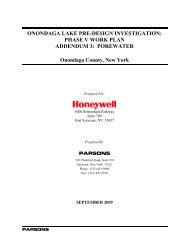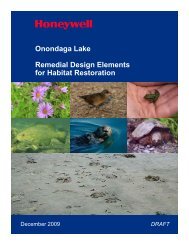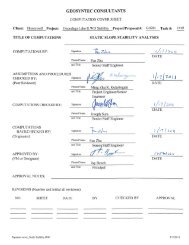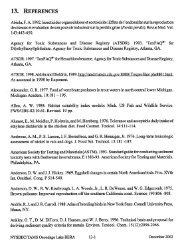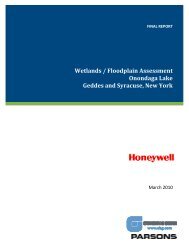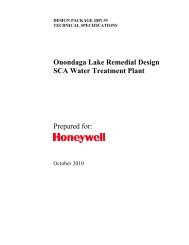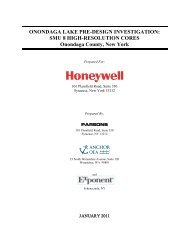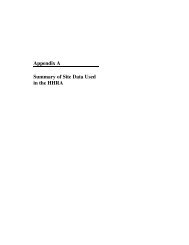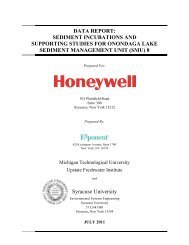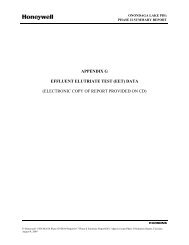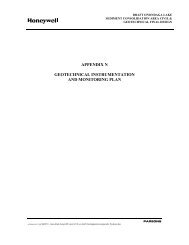Phase 1B Underwater Archaeological Report for the Onondaga ...
Phase 1B Underwater Archaeological Report for the Onondaga ...
Phase 1B Underwater Archaeological Report for the Onondaga ...
Create successful ePaper yourself
Turn your PDF publications into a flip-book with our unique Google optimized e-Paper software.
FINAL<br />
<strong>Phase</strong> IB <strong>Underwater</strong> <strong>Archaeological</strong> Resources <strong>Report</strong> <strong>for</strong> <strong>Onondaga</strong> Lake Superfund Site<br />
PRECONTACT/CONTACT PERIOD ARCHAEOLOGICAL SENSITIVITY FOR SUBMERGED SITES IN<br />
ONONDAGA LAKE<br />
As noted in this section, inland lakes as well as <strong>the</strong>ir margins and inlets/outlets, offered diverse<br />
resources and areas <strong>for</strong> habitation <strong>for</strong> precontact and post-contact Native American groups in <strong>the</strong><br />
Nor<strong>the</strong>ast. <strong>Onondaga</strong> Lake, one of <strong>the</strong> smaller Finger Lakes of New York State, was part of an<br />
interconnected system of waterways, all rich in aquatic and terrestrial resources. Adjacent dry land near<br />
riverine confluences offered ideal locations <strong>for</strong> short-term seasonal and/or long-term habitation sites.<br />
The lake itself and <strong>the</strong> surrounding environs (i.e. tributaries, wetlands, and <strong>for</strong>ests) would have provided<br />
fish, game, wood, and plants that made habitation in close proximity to <strong>the</strong> lake ideal. Additionally,<br />
travel and fishing activities on <strong>the</strong> lake may have involved <strong>the</strong> use of dugout and bark canoes.<br />
In support of this potential, <strong>the</strong>re are 29 documented Precontact/Contact period archaeological sites<br />
within 1.6 km radius (1 mile) of <strong>the</strong> shoreline of <strong>Onondaga</strong> Lake. All of <strong>the</strong>se sites are listed in <strong>the</strong> New<br />
York State SHPO database and are ei<strong>the</strong>r near <strong>Onondaga</strong> Lake or along major tributaries that flow into<br />
or out of <strong>the</strong> lake. 63 The known Precontact and Contact era archaeological site types are varied (small<br />
campsites, mounds, burial places, contact era villages) and demonstrate that Native American land use<br />
around <strong>Onondaga</strong> Lake was substantial, especially on dry land near confluences or on spits of land<br />
jutting into <strong>the</strong> lake. The presence of ceremonial and spiritual land use shows <strong>the</strong> importance of <strong>the</strong><br />
lake <strong>for</strong> activities o<strong>the</strong>r than resource procurement and settlement.<br />
Climate changes may have greatly influenced <strong>the</strong> way precontact peoples used <strong>the</strong> land around <strong>the</strong> lake.<br />
<strong>Onondaga</strong> Lake was <strong>for</strong>med roughly 10,000 B.P. when glacial lake Iroquois retreated. Since that time,<br />
<strong>the</strong> shoreline of <strong>Onondaga</strong> Lake may have been altered as lake levels fluctuated due to episodic drought<br />
or periods of increased moisture. As discussed previously, it is not currently possible to state exactly<br />
how <strong>the</strong>se climatic episodes impacted this particular body of water. However, given <strong>the</strong> historically<br />
known presence of wetland margins along <strong>the</strong> western shoreline of <strong>Onondaga</strong> Lake, and <strong>the</strong> presence of<br />
salt springs on <strong>the</strong> south and east portions of <strong>the</strong> lake, it is likely that <strong>Onondaga</strong> Lake was an important<br />
resource procurement area throughout <strong>the</strong> human history of <strong>the</strong> region.<br />
None of <strong>the</strong> known Precontact archaeological sites identified in <strong>the</strong> area are located on <strong>the</strong> immediate<br />
shoreline of <strong>Onondaga</strong> Lake. An exception may be <strong>the</strong> Contact period Kaneeda village site on <strong>the</strong> south<br />
shore of <strong>the</strong> lake near <strong>the</strong> outlet of <strong>Onondaga</strong> Creek. The location of <strong>the</strong> outlet changed over <strong>the</strong> years<br />
and <strong>the</strong> exact location of <strong>the</strong> village is not known. The absence of recorded sites adjacent to <strong>the</strong><br />
shoreline may be a result of <strong>the</strong> natural configuration of <strong>the</strong> shoreline. A great majority of <strong>the</strong> shoreline<br />
adjacent to <strong>the</strong> underwater APE <strong>for</strong> this project was once wetland and swamp, as noted on 18th and<br />
19th century maps (Figure 5: Late eighteenth century map of <strong>Onondaga</strong> Lake with <strong>the</strong> project shoreline<br />
APE labeled as swamps and springs.Figure 5). Today, this land is composed of made lands created<br />
through <strong>the</strong> deposition of waste fill (typically Solvay waste) by infilling shallow water areas or marshes.<br />
These marshes and wetland were likely attractive <strong>for</strong> resource procurement by Native American groups,<br />
but <strong>the</strong>y were less likely to be habitation areas.<br />
A geomorphological study of <strong>the</strong> land portion of <strong>the</strong> APE conducted by Geoarchaeology Research<br />
Associates(GRA) indicated that “thick marl deposits (found below fill in Wastebed B) are indicative of<br />
basin and subaqueous shoreline deposits, which are nei<strong>the</strong>r conducive to prehistoric settlement, nor<br />
archaeological preservation.” 64 The boring logs along <strong>the</strong> project APEs support <strong>the</strong> historic map<br />
in<strong>for</strong>mation which noted a variety of swamps adjacent to <strong>the</strong> lake. This characterization can be<br />
extended to <strong>the</strong> drowned shoreline where portions of <strong>the</strong> swamps noted on <strong>the</strong> late eighteenth century<br />
12



